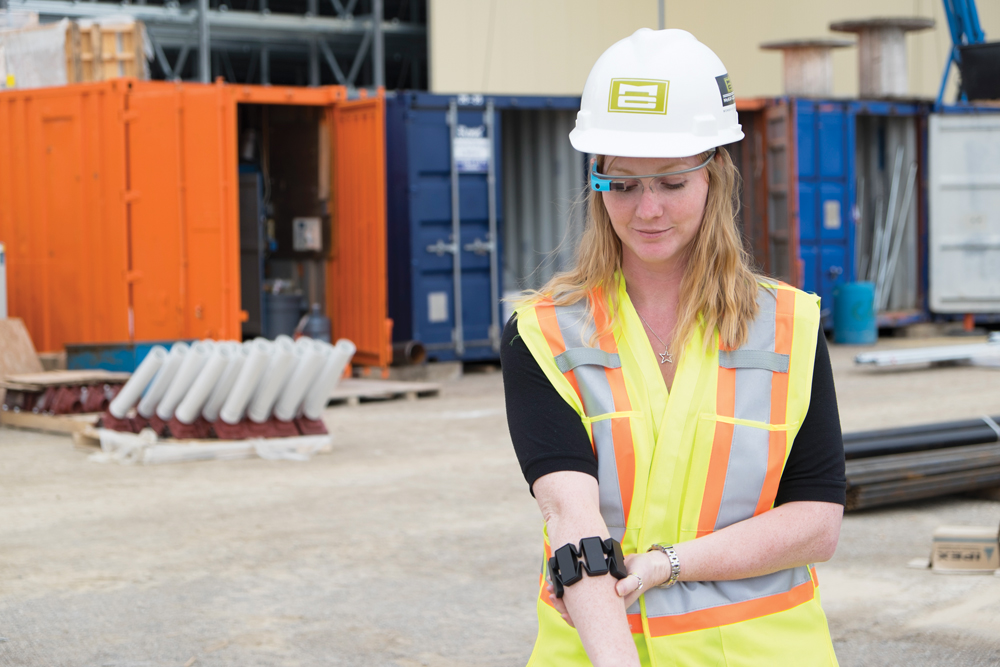Bridgit, a Canadian startup company devoted to improving efficiency in the construction industry, recently launched Groundbreaker. The interactive application combines the smartglass app for Bridgit’s flagship Closeout software, which manages deficiencies in construction projects, with Thalmic Labs’ Myo armband, which can recognize subtle hand and finger gestures.
Mallorie Brodie, Co-founder of the Kitchener, Ont., software developer, says that she and her Co-founder, Lauren Hasegawa, conferred with 500 stakeholders before deciding on the hands-free solution. “We were not convinced that smartglass technology alone was a practical solution, especially if it required audio commands on noisy job sites,” she says.
Combining the smartglass visual device with the motion-sensing armband means users don’t have to fiddle with their smartphones to shoot a photo of a defect in a wall system. Nor do they have to rely on using voice commands, which can slow down information retrieval in the field. They can just point and click, and the data or image can be transferred instantly to the correct person on site who can fix the problem.
Groundbreaker retails for $1,499. Here’s a short video demonstration of how it works.
Read about more innovations from BD+C's 2014 Great Solutions Report
Related Stories
| May 25, 2011
Developers push Manhattan office construction
Manhattan developers are planning the city's biggest decade of office construction since the 1980s, betting on rising demand for modern space even with tenants unsigned and the availability of financing more limited. More than 25 million sf of projects are under construction or may be built in the next nine years.
| May 25, 2011
Olympic site spurs green building movement in UK
London's environmentally friendly 2012 Olympic venues are fuelling a green building movement in Britain.
| May 25, 2011
TOTO tests universal design at the AIA conference
If you could be 80 years old for 30 minutes—and have to readjust everything you think you know about your own mobility—would you do it?
| May 20, 2011
Hotels taking bath out of the bathroom
Bathtubs are disappearing from many hotels across the country as chains use the freed-up space to install ever more luxurious showers, according to a recent USAToday report. Of course, we reported on this move--and 6 other hospitality trends--back in 2006 in our special report "The Inn Things: Seven Radical New Trends in Hotel Design."
| May 19, 2011
BD+C’s "40 Under 40" winners for 2011
The 40 individuals profiled here are some of the brightest stars in the AEC universe—and they’re under the age of 40. These young architects, engineers, contractors, designers, and developers stood out among a group of 164 outstanding entrants in our sixth annual “40 Under 40” competition.
| May 18, 2011
Sanford E. Garner on the profitability of being diverse
Sanford E. Garner, AIA, NOMA, LEED AP ND, NCARB, founding partner and president of A2SO4 Architecture, LLC, Indianapolis, on gentrification, the profitability of being diverse, and his goals as NOMA president.
| May 18, 2011
8 Tips for Designing Wood Trusses
Successful metal-plate-connected wood truss projects require careful attention to detail from Building Team members.
| May 18, 2011
Major Trends in University Residence Halls
They’re not ‘dorms’ anymore. Today’s collegiate housing facilities are lively, state-of-the-art, and green—and a growing sector for Building Teams to explore.
| May 18, 2011
Former Bronx railyard redeveloped as shared education campus
Four schools find strength in numbers at the new 2,310-student Mott Haven Campus in New York City. The schools—three high schools and a K-4 elementary school—coexist on the 6.5-acre South Bronx campus, which was once a railyard.
















